Page 16 of 140
1-6
1
YAMAHA MOTOR CO., LTD.
2500 SHINGAI, IWATA, JAPAN
******
*** kW
*** kg
****1
2
34 This pictogram shows trailer Hitch Tow
weight limit. (Combined weight of the trailer
and all cargo in the trailer.)
Overloading can cause loss of control.
Loss of control can result in severe injury or
death.
This pictogram shows trailer Hitch Tongue
weight limit. (Weight on the trailer tongue.)
Overloading can cause loss of control.
Loss of control can result in severe injury or
death.
1
2
3
4Year of construction
Model Name
Max. Power
Mass In Running Order
U1P066E0.book Page 6 Thursday, August 5, 2010 4:15 PM
Page 29 of 140
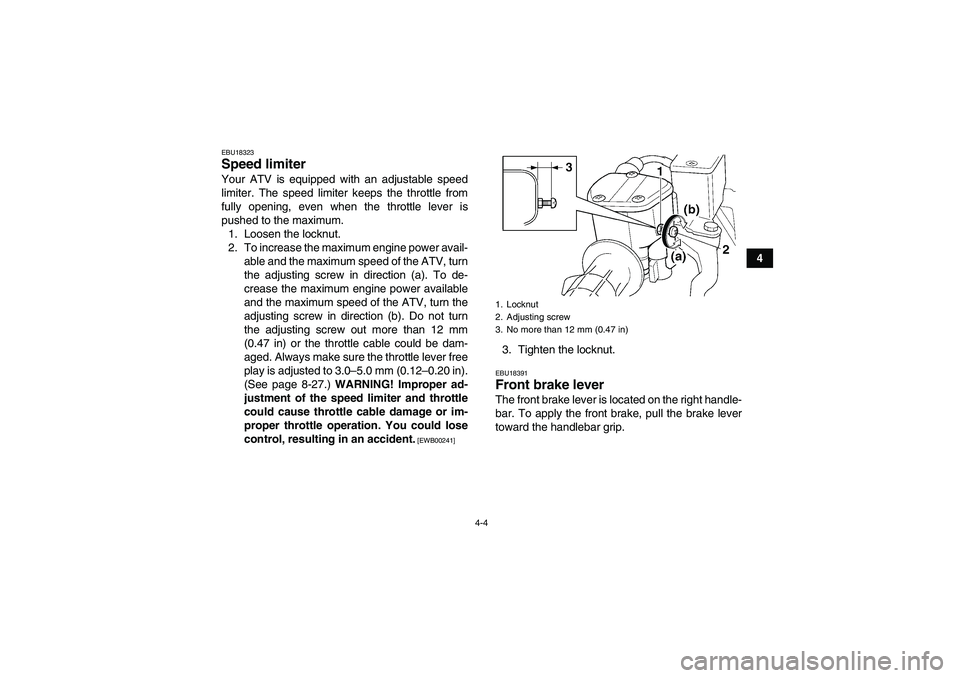
4-4
4
EBU18323Speed limiter Your ATV is equipped with an adjustable speed
limiter. The speed limiter keeps the throttle from
fully opening, even when the throttle lever is
pushed to the maximum.
1. Loosen the locknut.
2. To increase the maximum engine power avail-
able and the maximum speed of the ATV, turn
the adjusting screw in direction (a). To de-
crease the maximum engine power available
and the maximum speed of the ATV, turn the
adjusting screw in direction (b). Do not turn
the adjusting screw out more than 12 mm
(0.47 in) or the throttle cable could be dam-
aged. Always make sure the throttle lever free
play is adjusted to 3.0–5.0 mm (0.12–0.20 in).
(See page 8-27.) WARNING! Improper ad-
justment of the speed limiter and throttle
could cause throttle cable damage or im-
proper throttle operation. You could lose
control, resulting in an accident.
[EWB00241]
3. Tighten the locknut.EBU18391Front brake lever The front brake lever is located on the right handle-
bar. To apply the front brake, pull the brake lever
toward the handlebar grip.1. Locknut
2. Adjusting screw
3. No more than 12 mm (0.47 in)
U1P066E0.book Page 4 Thursday, August 5, 2010 4:15 PM
Page 30 of 140
4-5
4
EBU18442Brake pedal and rear brake lever The brake pedal is located on the right side of the
ATV and the rear brake lever is located on the left
handlebar. To apply the rear brake, push down on
the brake pedal or pull the brake lever toward the
handlebar grip.1. Front brake lever
1. Brake pedal
1. Rear brake lever
U1P066E0.book Page 5 Thursday, August 5, 2010 4:15 PM
Page 52 of 140
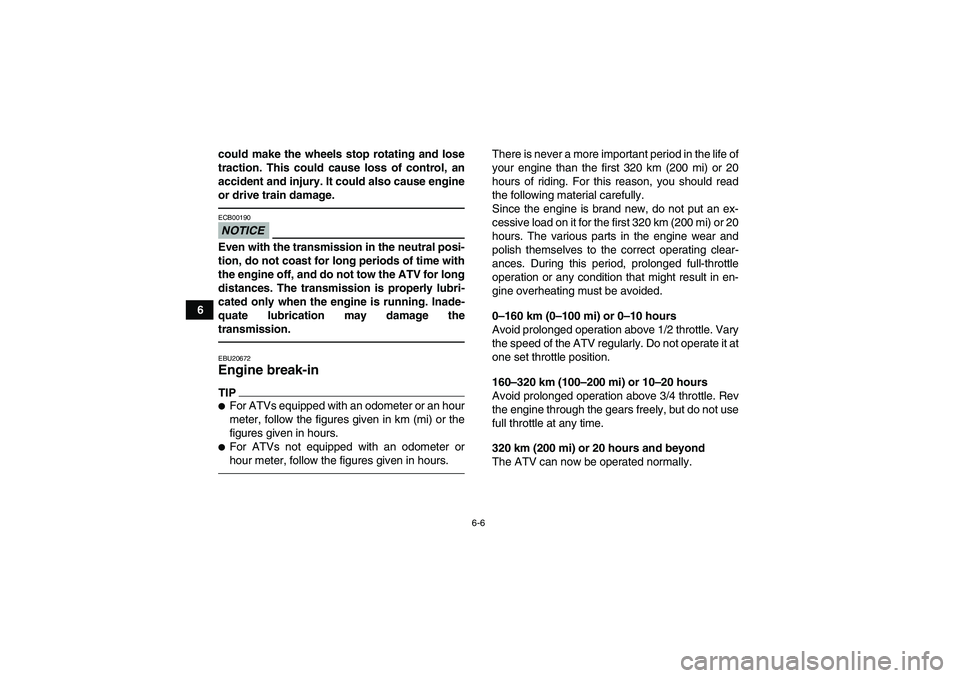
6-6
6could make the wheels stop rotating and lose
traction. This could cause loss of control, an
accident and injury. It could also cause engine
or drive train damage.
NOTICEECB00190Even with the transmission in the neutral posi-
tion, do not coast for long periods of time with
the engine off, and do not tow the ATV for long
distances. The transmission is properly lubri-
cated only when the engine is running. Inade-
quate lubrication may damage the
transmission.EBU20672Engine break-in TIP�For ATVs equipped with an odometer or an hour
meter, follow the figures given in km (mi) or the
figures given in hours.�For ATVs not equipped with an odometer or
hour meter, follow the figures given in hours.
There is never a more important period in the life of
your engine than the first 320 km (200 mi) or 20
hours of riding. For this reason, you should read
the following material carefully.
Since the engine is brand new, do not put an ex-
cessive load on it for the first 320 km (200 mi) or 20
hours. The various parts in the engine wear and
polish themselves to the correct operating clear-
ances. During this period, prolonged full-throttle
operation or any condition that might result in en-
gine overheating must be avoided.
0–160 km (0–100 mi) or 0–10 hours
Avoid prolonged operation above 1/2 throttle. Vary
the speed of the ATV regularly. Do not operate it at
one set throttle position.
160–320 km (100–200 mi) or 10–20 hours
Avoid prolonged operation above 3/4 throttle. Rev
the engine through the gears freely, but do not use
full throttle at any time.
320 km (200 mi) or 20 hours and beyond
The ATV can now be operated normally.
U1P066E0.book Page 6 Thursday, August 5, 2010 4:15 PM
Page 55 of 140
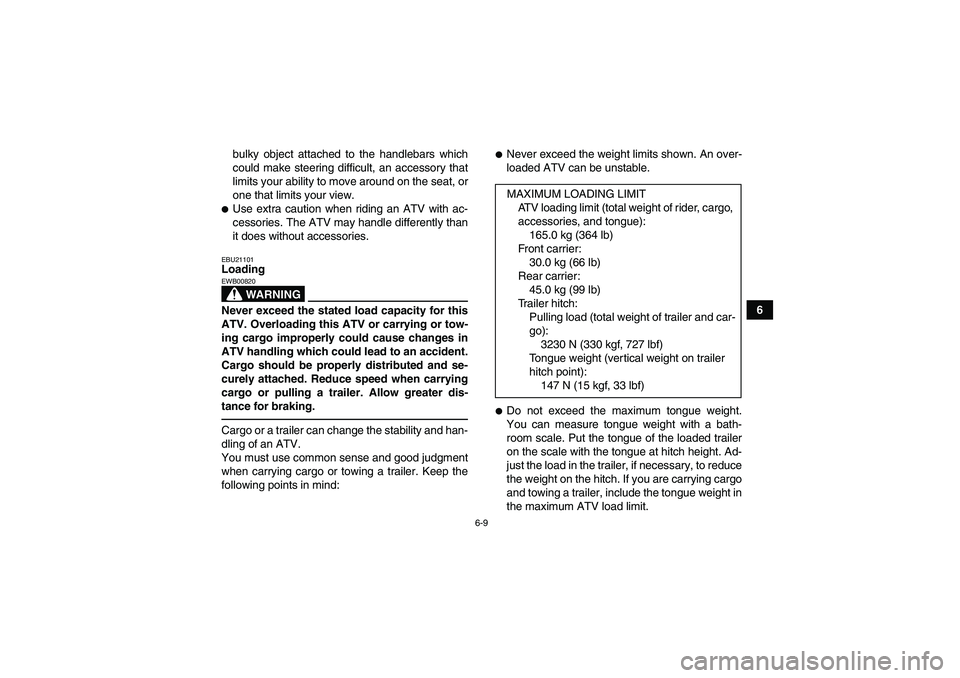
6-9
6 bulky object attached to the handlebars which
could make steering difficult, an accessory that
limits your ability to move around on the seat, or
one that limits your view.
�Use extra caution when riding an ATV with ac-
cessories. The ATV may handle differently than
it does without accessories.EBU21101Loading
WARNING
EWB00820Never exceed the stated load capacity for this
ATV. Overloading this ATV or carrying or tow-
ing cargo improperly could cause changes in
ATV handling which could lead to an accident.
Cargo should be properly distributed and se-
curely attached. Reduce speed when carrying
cargo or pulling a trailer. Allow greater dis-
tance for braking.Cargo or a trailer can change the stability and han-
dling of an ATV.
You must use common sense and good judgment
when carrying cargo or towing a trailer. Keep the
following points in mind:
�Never exceed the weight limits shown. An over-
loaded ATV can be unstable.�Do not exceed the maximum tongue weight.
You can measure tongue weight with a bath-
room scale. Put the tongue of the loaded trailer
on the scale with the tongue at hitch height. Ad-
just the load in the trailer, if necessary, to reduce
the weight on the hitch. If you are carrying cargo
and towing a trailer, include the tongue weight in
the maximum ATV load limit.MAXIMUM LOADING LIMIT
ATV loading limit (total weight of rider, cargo,
accessories, and tongue):
165.0 kg (364 lb)
Fron t c a rr ie r :
30.0 kg (66 lb)
Rear carrier:
45.0 kg (99 lb)
Trailer hitch:
Pulling load (total weight of trailer and car-
go):
3230 N (330 kgf, 727 lbf)
Tongue weight (ver tical weight on trailer
hitch point):
147 N (15 kgf, 33 lbf)
U1P066E0.book Page 9 Thursday, August 5, 2010 4:15 PM
Page 56 of 140
6-10
6
�Load cargo on the carriers as close to the center
of the ATV as possible. Put cargo at the rear of
the front carrier, at the front of the rear carrier,
and center it.�Tie down cargo securely to the carriers. Make
sure cargo in the trailer cannot move around. A
shifting load can cause an accident.�Make sure the load does not interfere with con-
trols or your ability to see where you are going.�Ride more slowly than you would without a load.
The more weight you carry, the slower you
should go. Although conditions vary, it is good
practice not to exceed 2nd gear whenever you
are carrying heavier loads or when towing a trail-
er.�Allow more braking distance. A heavier ATV
takes longer to stop.�Avoid making sharp turns unless at very slow
speeds.�Avoid hills and rough terrain. Choose terrain
carefully. Added weight affects the stability and
handling of the ATV.
U1P066E0.book Page 10 Thursday, August 5, 2010 4:15 PM
Page 62 of 140
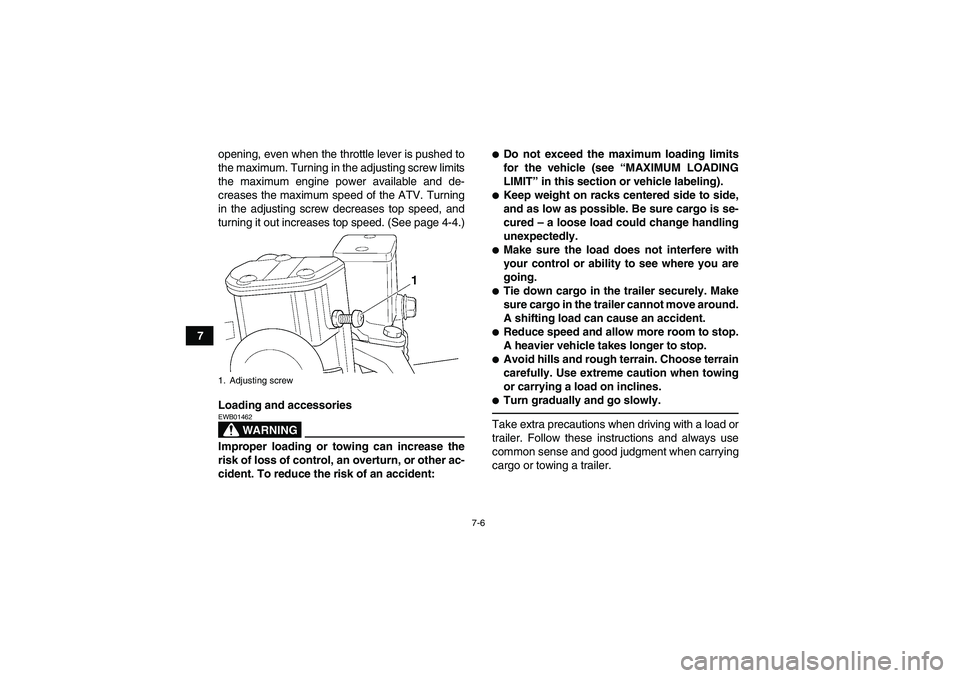
7-6
7opening, even when the throttle lever is pushed to
the maximum. Turning in the adjusting screw limits
the maximum engine power available and de-
creases the maximum speed of the ATV. Turning
in the adjusting screw decreases top speed, and
turning it out increases top speed. (See page 4-4.)
Loading and accessories
WARNING
EWB01462Improper loading or towing can increase the
risk of loss of control, an overturn, or other ac-
cident. To reduce the risk of an accident:
�Do not exceed the maximum loading limits
for the vehicle (see “MAXIMUM LOADING
LIMIT” in this section or vehicle labeling).�Keep weight on racks centered side to side,
and as low as possible. Be sure cargo is se-
cured – a loose load could change handling
unexpectedly.�Make sure the load does not interfere with
your control or ability to see where you are
going.�Tie down cargo in the trailer securely. Make
sure cargo in the trailer cannot move around.
A shifting load can cause an accident.�Reduce speed and allow more room to stop.
A heavier vehicle takes longer to stop.�Avoid hills and rough terrain. Choose terrain
carefully. Use extreme caution when towing
or carrying a load on inclines.�Turn gradually and go slowly.Take extra precautions when driving with a load or
trailer. Follow these instructions and always use
common sense and good judgment when carrying
cargo or towing a trailer.
1. Adjusting screwU1P066E0.book Page 6 Thursday, August 5, 2010 4:15 PM
Page 63 of 140
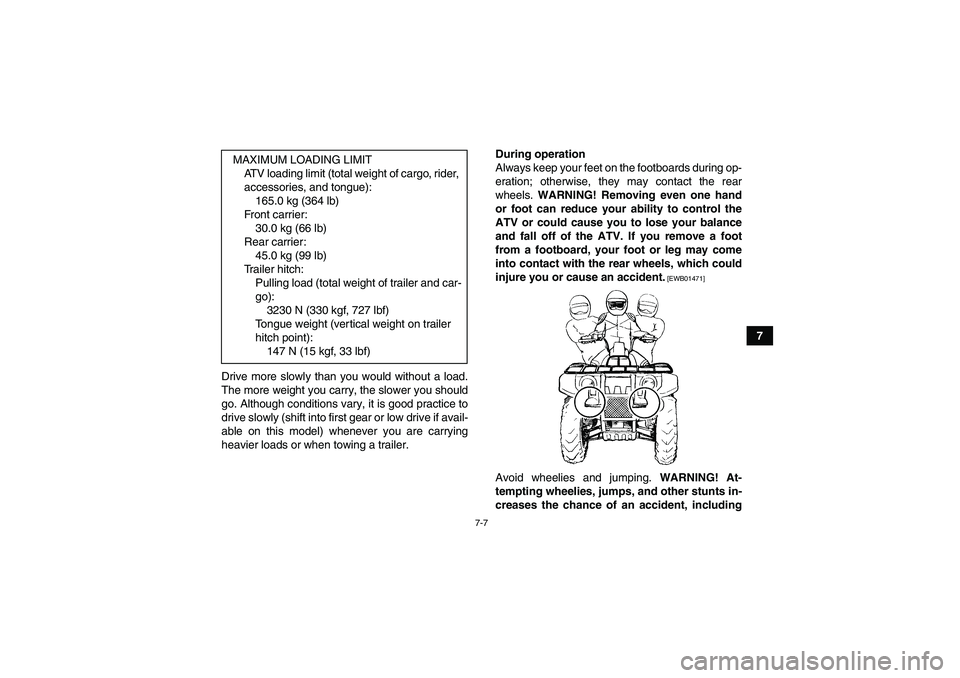
7-7
7
Drive more slowly than you would without a load.
The more weight you carry, the slower you should
go. Although conditions vary, it is good practice to
drive slowly (shift into first gear or low drive if avail-
able on this model) whenever you are carrying
heavier loads or when towing a trailer.During operation
Always keep your feet on the footboards during op-
eration; otherwise, they may contact the rear
wheels. WARNING! Removing even one hand
or foot can reduce your ability to control the
ATV or could cause you to lose your balance
and fall off of the ATV. If you remove a foot
from a footboard, your foot or leg may come
into contact with the rear wheels, which could
injure you or cause an accident.
[EWB01471]
Avoid wheelies and jumping. WARNING! At-
tempting wheelies, jumps, and other stunts in-
creases the chance of an accident, including MAXIMUM LOADING LIMIT
ATV loading limit (total weight of cargo, rider,
accessories, and tongue):
165.0 kg (364 lb)
Fron t c a rr ie r :
30.0 kg (66 lb)
Rear carrier:
45.0 kg (99 lb)
Trailer hitch:
Pulling load (total weight of trailer and car-
go):
3230 N (330 kgf, 727 lbf)
Tongue weight (ver tical weight on trailer
hitch point):
147 N (15 kgf, 33 lbf)
U1P066E0.book Page 7 Thursday, August 5, 2010 4:15 PM